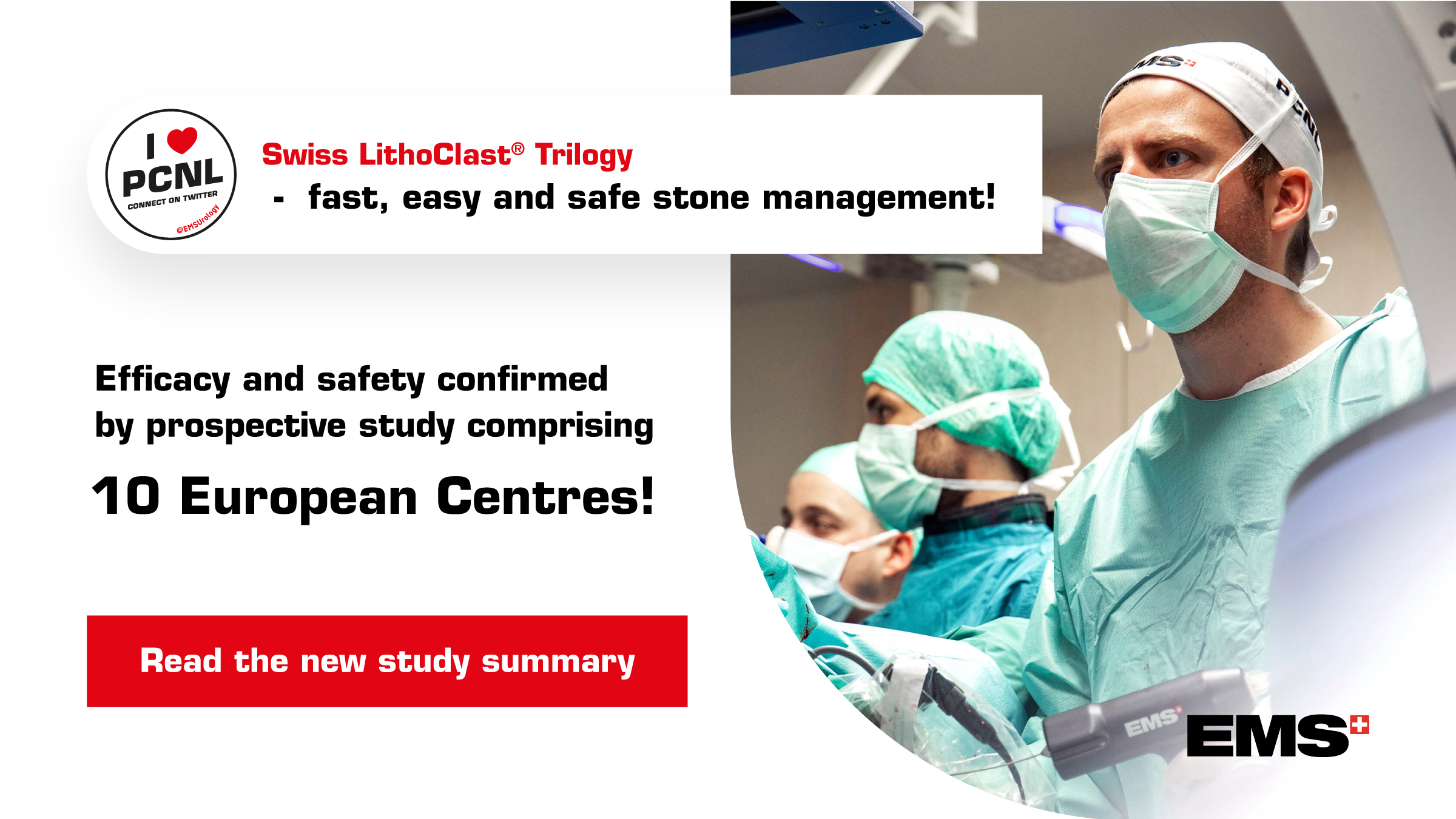
Efficacy and safety confirmed by prospective study comprising 10 European Centres!
Multicentre prospective study on behalf of the European Section of UroTechnology (ESUT). Published in the World Journal of Urology.
Study background:
The main purpose of this study was to determine the efficacy and safety of the Swiss LithoClast® Trilogy in patients undergoing percutaneous nephrolithotomy (PCNL), via a prospective European multicentre evaluation.
The study was designed as a result of collaboration between 10 European Centres. 157 PCNL procedures with the use of EMS Swiss LithoClast® Trilogy were included and prospectively analysed.
Primary outcomes measures of the study were defined as:
- stone-free rate (assessed on imaging either in the immediate post-operative period or at follow-up)
- stone clearance efficiency (calculated using stone cross-sectional area divided by probe active time (in mm2/min) or calculated using three-dimensional stone volume divided by probe activity time (in mm3/min)),
- surgeon’s feedback on a 1-10 VAS (concerning ergonomics; ultrasound, ballistic, combination, and suction effectiveness; summarized conclusion comparator: most commonly used previous lithotrite).
Additionally, the researchers investigated:
- Visual clearance, defined as no visible stone fragments seen in the collecting system at the end of the procedure endoscopically, and clearance on fluoroscopy were noted by the surgeon at the end of the procedure
- Potential device malfunction
- adverse events and postoperative complications.
Results proved that Swiss LithoClast® is highly effective and safe for stone removal.
- Stone clearance rate - 90% as visually determined by endoscopy and 83% assessed with fluoroscopy imaging!
- Post-operative stone-free rate according to Guy’s stone score (I, II, III, IV) was 89%, 97%, 84%, and 65% for fluoroscopy and 94%, 100%, 89% and 73% for visual clearance.
- Overall 81.4% stone-free rate in follow-up evaluation!
Assessed by experienced surgeons - fast, easy and safe stone management!
Feedback from surgeons was obtained after each procedure, evaluated parameters were assessed with 0-10 score (10 = extremely effective).
Confirmed safety and reliability with Swiss LithoClast® Trilogy!
- Confirmed probe durability: In 94.3% of cases, the probe inserted in the endoscope successfully delivered the 3 modalities of Swiss LithoClast® Trilogy (ballistrics, ultrasound and suction). Probe breakage occurred only in 9 (5.7%) cases – the probe replacement with the easy-to-use torque wrench was sufficient to continue the procedure without the need to switch to another lithotrite. Confirmed safety:
- Intraoperative complication: 1 (0.6%) (renal pelvis perforation) out of 157 surgeries
- Overall postoperative adverse events – 15 (9.5%) (Clavien I-II complications: fever, urosepsis, blood transfusion, AV fistula, abdominal wall and perineal hematoma and extracorporeal lithotripsy for ureteric fragments). There were no major complications (Clavien IV and V) reported during the study.
Conclusion
This is the first multicentre study which prospectively evaluated the efficiency and safety of the Swiss LithoClast® Trilogy device on a large cohort of patients. From a user perspective, the device was perceived by surgeons to be highly effective overall and compared to the most commonly used previous lithotrite, with an excellent safety profile. Therefore, it brings another vital piece of evidence pointing out the efficacy, safety and reliability of the Swiss LithoClast® Trilogy for percutaneous nephrolithotomy.
The study authors noted that the high stone-free rates and the stone-clearance volume were despite the fact that the surgeons just started using this new device. The probe breakage rate could have also been effected by the surgeon learning curve or related to specific compatibility issues between the Swiss LithoClast® Trilogy device and the nephroscope which it is used with. Therefore, the authors noted a need for further investigation.
